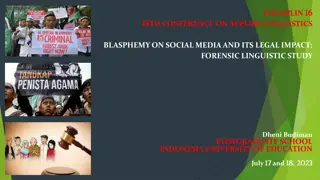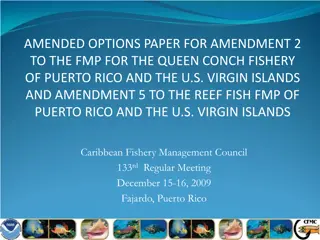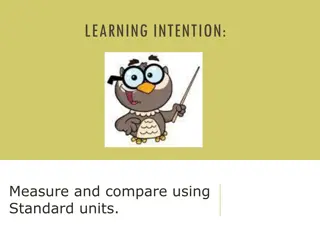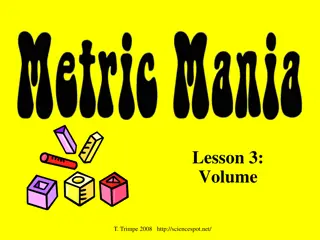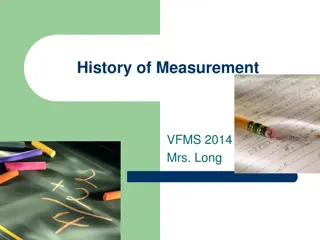Understanding Sampling Methods in Social Research
Sampling in social research involves selecting a subset of a population to make inferences about the whole. It helps in saving time and money, ensures accuracy in measurements, and allows estimation of population characteristics. The key principles of sampling include systematic selection, clear def
1 views • 19 slides
Multiplying recruiting units
This presentation delves into the key relationships between church growth and the number, age, and mission of church units, emphasizing the correlation between membership strength and the number of units. It also discusses the importance of starting new churches for denominational growth, Sunday sch
2 views • 28 slides
Innovative Air-Cooling Equipment for Electronics
The design and use of air-cooling equipment in electronics to ensure environmental-friendliness is explored in this study by Vacek V. from Czech Technical University. The equipment is designed to meet demanding requirements for high-tech electronics applications, providing precise temperature regula
0 views • 17 slides
Impact of Blasphemy on Social Media: Forensic Linguistic Analysis
Language plays a crucial role in human communication, especially on social media platforms where public speech can have legal consequences. This research delves into the concept of blasphemy on social media and its legal implications, focusing on linguistic forensic study. It explores how language c
7 views • 24 slides
ENGLISH PHRASEOLOGY.THE ENGLISH VOCABULARY STRATIFICATION.
Explore the concept of phraseological units, various classifications, categorial features, and semantic relations in phraseology, along with the stylistic stratification of the English vocabulary, covering literary words, colloquial words, and different types of word combinations. Discover how phras
5 views • 22 slides
Fundamentals of Mechanics: Introduction to Basic Quantities and Units
Explore the foundational concepts of mechanics in this introductory lecture, covering basic quantities like length, time, mass, and force. Learn about idealizations, units of measurement, SI units, conversion of units, and prefixes used in the context of mechanics.
3 views • 7 slides
Exploring Bantu Phonology and Linguistic Classification
Delve into the intriguing world of Bantu phonology and linguistic classification, covering the diverse sounds and phonological processes found in Bantu languages. Discover the rich heritage of over 500 Bantu languages in sub-Saharan Africa, classified into zones and classes, shedding light on the fa
0 views • 38 slides
Understanding Customary Units of Capacity
Explore the world of customary units of capacity including ounces, cups, pints, quarts, and gallons. Learn how these units are used in measuring liquids, such as fluid ounces, cups, pints, and more. Dive into the fascinating story of the kingdom of GALLON and its royal family. Discover practical exa
0 views • 15 slides
Understanding Metric Measurements and Units
Exploring various metric units for measuring length, mass, and capacity. Matching lengths to sensible estimates, defining mass, length, and capacity, and sorting metric units into appropriate categories. Determining the most suitable units to measure mass and capacity for different objects and estim
0 views • 14 slides
Understanding Language Teaching Syllabus: Integration, Theory, and Approaches
Language Teaching Syllabus involves the integration of subject matter and linguistic elements, guided by theories of language and learning. Various approaches like Grammatical, Situational, Communicative, and Analytic are used to structure syllabi. Breaking language into parts aids in sequential lea
1 views • 28 slides
Understanding Metric Units of Measurement in Mathematics
Explore the world of metric units in mathematics through the measurement of length, weight, and capacity. Learn about converting between units and applying these concepts to real-world scenarios. Discover the properties of shapes and delve into 3D shapes by counting faces, edges, and vertices. Engag
1 views • 21 slides
Understanding Metric Systems and Significant Figures
Scientists worldwide use the SI system to communicate clearly, based on units like meter, gram, and liter. Learn about base and derived units, SI base units like second and kilogram, and derived units like volume. Discover which unit (millimeter, centimeter, meter, or kilometer) to use for different
0 views • 36 slides
Understanding Units of Measure in Math and Science
Introduction to units of measure including the metric system and US/Customary system. Learn about the basics of measuring length, volume, weight, and mass. Explore different units such as meters, liters, and grams, and understand the importance of choosing and interpreting units in various contexts.
0 views • 17 slides
Understanding Units and Measurements in Physics
Physics is the study of nature and its phenomena, involving various physical quantities like mass, length, time, area, and volume. These quantities can be fundamental or derived, with units selected as standards for measurement. The System International (SI) units offer advantages like coherence, ra
0 views • 14 slides
Academic Planning Training Summit Exec Order 1071 - Units & Concentrations
Explore Executive Order 1071 delegating authority for subprograms in academic planning. Learn about counting units, adding concentrations, and major requirements. Guidance documents and comparisons help understand the core curriculum and exclude elective units. Dive into discipline major units, conc
0 views • 12 slides
Linguistic Microaggressions in Messaging about DLD: Thoughts and Suggestions
Linguistic microaggressions in the discourse surrounding Developmental Language Disorder (DLD) can perpetuate negative stereotypes and harm individuals. This content discusses the concept of linguistic microaggressions, explores the ambiguity in messaging about DLD, and highlights the importance of
3 views • 12 slides
Introduction to Masonry Units in Construction
Masonry units, such as stone, blocks, or bricks, combined with mortar, are essential in construction, with examples seen in the pyramids of Egypt and the Great Wall of China. Structured and non-structured masonry types serve different purposes, with concrete masonry units being widely used. Solid co
1 views • 33 slides
Culturally Responsive Biliteracy in Inclusive Education
Culturally responsive biliteracy in inclusive education emphasizes the importance of teaching in two languages, valuing diverse cultural and linguistic identities, and creating a participatory and inclusive classroom environment. Educators play a crucial role in fostering language development and ac
0 views • 12 slides
Understanding Scientific Method and Units in Chemistry.
Learn about designing controlled experiments, identifying variables, and understanding constants through scenarios involving bacteria cultures and pizza grease comparison. Explore the differences between theory and law in scientific context, and discover the base units and metric units used in chemi
2 views • 30 slides
Proposed Stock Complex Amendments for Caribbean Reef Fishery Management Units
Amendments proposed for the reef fishery management units in Puerto Rico and the U.S. Virgin Islands include changes to stock complexes for parrotfish, grouper, and snapper units. The proposal suggests separating parrotfish units, modifying grouper units, and adjusting snapper units. Additionally, t
4 views • 72 slides
The Three Modules of Phonology and Multiple-Module Spell-Out Systems
Phonology is structured into three modules - Sonority, Laryngeal, and Place - each with its own vocabulary and skeleton for computation. These modules interact in multiple-module spell-out systems to map linguistic structures onto phonetic realizations. Sonority, involving the audibility of linguist
0 views • 67 slides
Syntactic Reconstruction from Linguistic Fossils in Uralic Languages
Linguistic fossils provide valuable insights for syntactic reconstruction in Uralic languages like Hungarian, Eastern Khanty, and Samoyedic. Through a case study, constraints on topical objects and grammatical systems are examined using linguistic fragments.
0 views • 34 slides
Measurement Comparison Activities for Learning Standard Units
Engage in interactive activities to practice measuring and comparing using standard units like centimeters, millimeters, meters, and kilometers. Test your knowledge with true or false questions and choose the correct units for various objects. Enhance your understanding of measuring tools and units
0 views • 20 slides
Understanding Volume Measurement in Metric Units
Explore the concept of volume measurement in metric units through lessons on English vs. metric units, measuring liquid volume with graduated cylinders, and calculating solid volume using formulas. Understand the relationship between liters, milliliters, and other units, and learn practical techniqu
0 views • 6 slides
Walton High School Academic Program & Graduation Requirements
Walton High School aims to educate, inspire, and empower students in the Class of 2028 through a structured academic program. The school follows a 7-period day system where students take six classes and have lunch. With a total requirement of 24 units over four years, each class earns 0.5 units of c
0 views • 33 slides
Understanding Linguistic and Literary Stylistics
Linguistic Stylistics explores devices in language of literary texts to create expressive styles. Literary criticism relies on subjective interpretation, while Stylistic Analysis in linguistics identifies patterns in speech and writing. This content delves into the phonological, graphological, and l
0 views • 17 slides
Evolution of Measurement Systems Over Time
Explore the fascinating journey of measurement systems from historical units like cubit and fathom to the modern metric system. Discover how civilizations developed standardized units for length, weight, and mass. Follow the timeline of measurement advancements, from King Edward's iron ulna to the b
0 views • 36 slides
Evolution of the International System of Units (SI) and Its Base Units
The International System of Units (SI) was introduced in France in 1840 and became globally accepted by the mid-20th century. SI is mandatory in Estonia since 1982, with base units including meter, kilogram, second, ampere, kelvin, candela, and mole. Each base unit is defined by specific physical co
0 views • 22 slides
The Extension Dogma: Exploring Meaning and Extensions in Linguistic Expressions
The Extension Dogma challenges the assumption that linguistic expressions inherently possess meanings. Instead, it posits that expressions have extensions without necessary meanings that determine them. Theories of meaning should focus on the extensions of expressions, while psychological studies of
0 views • 30 slides
Introduction to arTenTen: A New Vast Corpus for Arabic Linguistic Processing
arTenTen is a new corpus for Arabic containing a vast array of text types, rich metadata, and clean linguistic processing capabilities. It offers a significant improvement over existing Arabic corpora, presenting a larger dataset with a variety of linguistic features. The corpus is fully processed,
0 views • 8 slides
Reasoning with Dependency Structures and Lexicographic Definitions using Unit Graphs
This piece discusses the application of knowledge representation in addressing recurrent needs related to manipulating, querying, reasoning, and sharing information, particularly in the linguistic domain of Meaning-Text Theory. Maxime Lefrançois and Fabien Gandon explore formalisms, such as the the
0 views • 56 slides
Understanding Metric and Imperial Measurements in Maths
Explore the world of metric and imperial measurements in mathematics, covering units for length, mass, and capacity. Learn conversion rates and relationships between different units, enhancing your functional maths skills at levels 1 and 2. Discover the significance of milli-, centi-, and kilo- pref
0 views • 11 slides
Understanding Units of Measurement in Physics
Explore the world of physics through the lens of units of measurement, including the Metric System and MKS/SI base units. Learn about the standard kilogram, meter, and second, as well as derived units and the process of converting units in the Metric System.
0 views • 22 slides
Understanding Dimensions, Dimensional Homogeneity, and Units in Fluid Mechanics
Qualitatively and quantitatively defining fluid characteristics involves dimensions and units such as length, time, stress, and velocity. Primary units like Length (L), Time (T), Mass (M), and Temperature provide a basis for describing secondary quantities. Dimensional homogeneity equations play a c
0 views • 19 slides
Understanding Structuralism in Linguistics: An Overview
Structuralism emerged as a dominant approach in linguistic studies from the 1920s to the 1960s, led by figures like Ferdinand de Saussure. This philosophical perspective focused on the study of language as a stable system of signs, emphasizing the interrelation of mental representations of sounds an
1 views • 28 slides
Understanding Linguistic Features in Trademarks and Branding
Explore the nuances of linguistic features in trademarks and branding through topics such as generic vs. name-like words, trade mark infringement cases, capitalization norms, and the significance of corpus analysis in understanding language usage in branding. Discover how linguistic expertise plays
0 views • 22 slides
Understanding Linguistic Anthropology and Anthropology: A Comprehensive Overview
Delve into the realm of linguistic anthropology and anthropology to explore the study of humans, culture, language, biology, artifacts, and more. Discover the four fields of anthropology, the holistic approach, and the importance of cultural relativism while avoiding ethnocentrism. Learn how linguis
0 views • 25 slides
Exploring Diachronic Typology and Linguistic Diversity
Delve into the fascinating realm of diachronic typology and linguistic properties across languages in time and space. Uncover the distribution of linguistic features, the past tense in various languages, and the underlying constraints shaping language structures. Discover the intricate interactions
0 views • 99 slides
The Principle of Arbitrariness in Linguistic Signs: Saussure's Insight
Saussure's declaration on the arbitrariness of linguistic signs is thought-provoking, emphasizing that while signs are arbitrary, complete arbitrariness would lead to chaos. He distinguishes between degrees of arbitrariness and acknowledges that signs are not entirely arbitrary, being subject to lin
0 views • 9 slides
Enhancements to CRIA2 Program for Tracking ARP Funded Services
The CRIA2 program now allows for tracking of ARP service units with added ARP Service Types. Agencies can contact the NWD Helpdesk for support on tracking ARP services. The Units Entry screen in CRIA Encounters is used to enter and track service units for encounters where ARP services will be tracke
0 views • 8 slides



